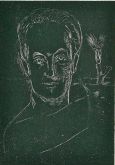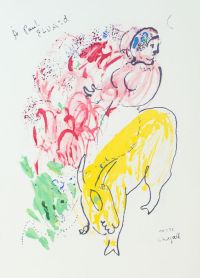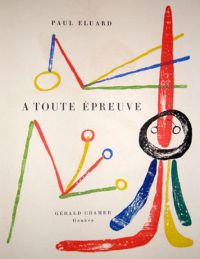Before surrealism was officially founded in 1924 when André Breton wrote Le Manifeste du Surréalisme, a group of young writers that included Paul Éluard, André Breton, Louis Aragon and Philippe Soupault, were active in the Dadaist movement. It was during this time that French poet Paul Éluard, in collaboration with German Dadaist Max Ernst, produced in 1922 the first major work of art – “Répétitions.” Prior to that the only other drawing to accompany Éluard’s poetry was in 1917, with a single etching by André Deslignères in “Le Devoir et l’Inquiétude.”
After “Répétitions,” Paul Éluard’s collaboration with Max Ernst took a different form as they entered into a ménage a trois living arrangement with Éluard’s wife Gala, resulting in a marital crisis. Nevertheless, Paul and Ernst published together four more books – “Mourir de ne pas mourir,” in 1924, “Au défaut du silence” in 1925, “Les Dessous d’une vie ou la Pyramide humaine,” in 1926 and “À l’intérieur de la vue,” much later in 1947. “Mourir de ne pas mourir,” was published in a limited edition of 545 copies and it included a portrait frontispiece of Éluard drawn by Max. “Au défaut du silence,” with 20 drawings was greatly influenced by time spent together with Gala. The edition was limited to 51 copies including one on Japan, and 50 copies on Holland, bringing together four poems (two in verse: “Ta chevelure d’orange” and “Ta bouche aux lèvres d’or”; two in prose: Les lumières dictées” and “Elle est – mais elle n’est qu’à minuit.”) The third book, “Les Dessous d’une vie ou la Pyramide humaine,” also was published with just a portrait drawn by Max Ernst in a total edition of 522 copies. And, last but not least, “À l’intérieur de la vue” includes 39 collages with a total of 610 copies released.
Gala and Éluard separated when she left him for Salvador Dalí, with whom she remained for the rest of her life. Gala’s departure proved to be a relatively small incident in Éluard’s life, as it did not seem to cause any disruptions to the two surrealists’ relationship, which carried on with “L’Immaculée Conception,” in 1930; “Notes sur la poésie,” in 1936 and “Cours naturel,” in 1938. The first two were also in collaboration with André Breton who had also worked with Éluard on a number of other books including “Ralentir travaux;” a 1930 dedication to Benjamin Péret, which was limited to 300 copies.
Up next it was Man Ray followed by Pablo Picasso, and a new wife for Éluard. In 1934, he married Nusch (Maria Benz); a model who was considered somewhat of a mascot of the surrealist movement, and whom Éluard had met through his two new friends Man Ray and Pablo Picasso. Together with Man Ray, Éluard produced “Facile,” in 1935; “Les Mains libres” and “La photographie n’est pas l’art,” in 1937. Picasso’s artwork appeared in “Les Yeux fertiles,” in 1936 with 4 illustrations provided in an edition limited to 1500, as well as in “Picasso Dessins” in 1952, the year of Éluard’s death.
Paul Éluard’s works continued to inspire artistic renditions long after his death. The high watermark of Miró’s career as a book-illustrator came in the 1958 edition of “À toute épreuve,” which was released in 130 copies only. For this edition Miró cut 233 woodcuts with the collaboration of Enric Tormo, 80 of which were included in this publication. These famous prints, some of which were enhanced with original collages, were prepared and printed by Jacques Frélaut at the famous Atelier Lacourière in Paris. While the original 1930 edition of Éluard’s poetry can be purchased inexpensively for around 100 Euro, the Miró composition commands more than 50,000 Euro.; A tremendous capital appreciation that Éluard showed his disapproval of, by joining the French Communist Party in 1942 and signaling his separation from the Surrealists and the dawn of his Joseph Stalin political writings.




{ 0 comments… add one now }
{ 3 trackbacks }